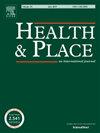The association between neighbourhood socioeconomic status and parental mental health in the first years after birth – Cross-sectional results from the SKKIPPI project
IF 3.8
2区 医学
Q1 PUBLIC, ENVIRONMENTAL & OCCUPATIONAL HEALTH
引用次数: 0
Abstract
Background
The urban environment can influence mental health. However, research on neighbourhood influences on mental health of parents with young children is sparse. This study aimed to analyse the association between neighbourhood socioeconomic status (SES) and mental health outcomes in urban parents in the first years after birth.
Methods
We included 4707 parents of young children who participated in the SKKIPPI cohort study in Berlin. Data on mental health outcomes (symptoms of depression, anxiety, or both, measured via PHQ- 4) and individual risk factors stemmed from an online questionnaire and were matched with neighbourhood level data from the Berlin Senate Department for Urban Development and Housing. Neighbourhood status (exposure) was categorized in 4 SES categories: high, medium, low, and very low. We use propensity scores to estimate the probability to live in each neighbourhood category to reduce the risk of bias due to neighbourhood self-selection. Binominal generalised linear mixed models with propensity score adjustment were used to estimate the association between neighbourhood SES and symptoms of depression, anxiety, or both.
Results
Overall, 9.3% of parents showed depressive, 10.3% anxiety, and 5.3% both symptoms. The occurrence of mental health problems was lowest in neighbourhoods with high SES and highest in neighbourhoods with low/very low SES. The association between neighbourhood SES and mental health outcomes seen in unadjusted regression models disappeared when models were adjusted for individual risk factors/neighbourhood self-selection using propensity scores.
Conclusion
We found no association between neighbourhood SES and mental health outcomes in parents in the first years after birth after adjusting for neighbourhood selection. Nevertheless, the unadjusted findings suggest that the occurrence of individual risk factors and mental health problems was highest in neighbourhoods with low/very low SES, which should be focus for social and preventive health measures.
出生后头几年邻里社会经济地位与父母心理健康之间的关系——SKKIPPI项目的横断面结果。
背景:城市环境可以影响心理健康。然而,关于邻里关系对幼儿父母心理健康影响的研究却很少。本研究旨在分析城市父母出生后第一年社区社会经济地位(SES)与心理健康结果之间的关系。方法:我们纳入了4707名参加柏林SKKIPPI队列研究的幼儿父母。心理健康结果(抑郁、焦虑症状,或两者都有,通过PHQ- 4测量)和个人风险因素的数据来源于一份在线问卷,并与柏林参议院城市发展和住房部的社区数据相匹配。邻里状况(暴露)分为4个SES类别:高、中、低和极低。我们使用倾向分数来估计居住在每个社区类别中的概率,以减少由于社区自我选择而产生的偏见风险。采用倾向评分调整的二项广义线性混合模型来估计社区社会经济地位与抑郁、焦虑或两者症状之间的关联。结果:总体而言,9.3%的家长表现为抑郁,10.3%的家长表现为焦虑,5.3%的家长表现为双症状。在社会经济地位高的社区,精神健康问题的发生率最低,而在社会经济地位低/非常低的社区,精神健康问题的发生率最高。当使用倾向评分对个体风险因素/社区自我选择进行调整时,未调整回归模型中邻里社会经济地位与心理健康结果之间的关联消失。结论:在调整邻里选择后,我们发现邻里社会经济地位与父母出生后第一年的心理健康状况没有关联。然而,未经调整的调查结果表明,个体风险因素和精神健康问题的发生率在社会经济地位低/非常低的社区最高,这应成为社会和预防保健措施的重点。
本文章由计算机程序翻译,如有差异,请以英文原文为准。
求助全文
约1分钟内获得全文
求助全文
来源期刊

Health & Place
PUBLIC, ENVIRONMENTAL & OCCUPATIONAL HEALTH-
CiteScore
7.70
自引率
6.20%
发文量
176
审稿时长
29 days
期刊介绍:
he journal is an interdisciplinary journal dedicated to the study of all aspects of health and health care in which place or location matters.
 求助内容:
求助内容: 应助结果提醒方式:
应助结果提醒方式:


